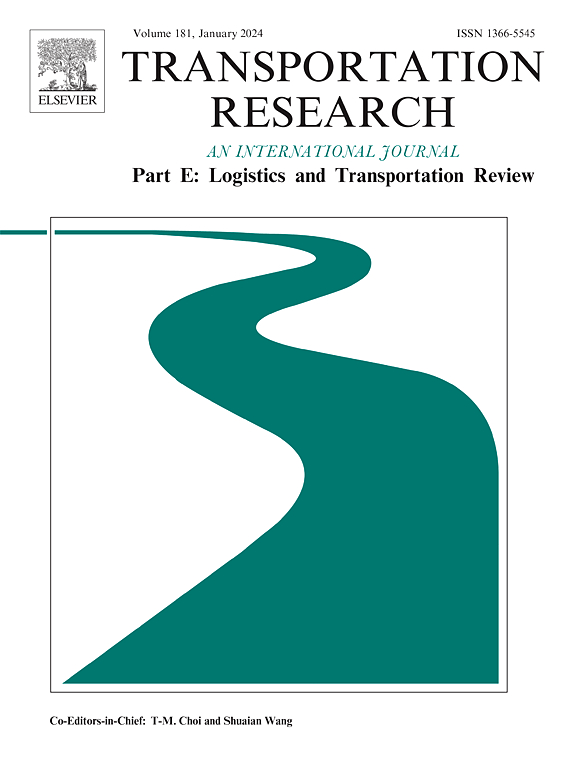A data-driven approach for spatio-temporal causal analysis in large-scale urban traffic networks
IF 8.3
1区 工程技术
Q1 ECONOMICS
Transportation Research Part E-Logistics and Transportation Review
Pub Date : 2025-07-21
DOI:10.1016/j.tre.2025.104244
引用次数: 0
Abstract
Understanding causal relationships between traffic states throughout the system is of great significance for enhancing traffic management and optimization in urban traffic networks. Unfortunately, few studies in the literature have systematically analyzed causal structure characterizing the evolution of traffic states over time and gauged the importance of traffic nodes from a causal perspective, particularly in the context of large-scale traffic networks. Moreover, the dynamic nature of traffic patterns necessitates a robust method to reliably discover causal relationships, which are often overlooked in existing studies. To address these issues, we propose a Spatio-Temporal Causal Structure Learning and Analysis (STCSLA) framework for analyzing large-scale urban traffic networks at a mesoscopic level from a causal lens. The proposed framework comprises three main components: decomposition of spatio-temporal traffic data into localized traffic subprocesses; a Bayesian Information Criterion-guided spatio-temporal causal structure learning combined with temporal-dependencies preserving sampling for deriving reliable causal graph to uncover time-lagged and contemporaneous causal effects; establishing several causality-oriented indicators to identify causally critical nodes, mediator nodes, and bottleneck nodes in traffic networks. Experimental results on both a synthetic dataset and the real-world Hong Kong traffic dataset demonstrate that the proposed STCSLA framework accurately uncovers time-varying causal relationships and identifies key nodes that play various causal roles in influencing traffic dynamics. These findings underscore the potential of the proposed framework to improve traffic management and provide a comprehensive causality-driven approach for analyzing urban traffic networks.
大型城市交通网络时空因果分析的数据驱动方法
了解整个系统中交通状态之间的因果关系,对于加强城市交通网络的交通管理和优化具有重要意义。不幸的是,文献中很少有研究系统地分析表征交通状态随时间演变的因果结构,并从因果角度衡量交通节点的重要性,特别是在大规模交通网络的背景下。此外,交通模式的动态性需要一种可靠的方法来可靠地发现因果关系,这在现有的研究中经常被忽视。为了解决这些问题,我们提出了一个时空因果结构学习与分析(STCSLA)框架,从因果角度在中观层面分析大规模城市交通网络。该框架包括三个主要部分:将时空交通数据分解为局部交通子过程;基于贝叶斯信息准则的时空因果结构学习与时间依赖保持抽样相结合,获得可靠的因果图,揭示时滞和同步因果效应;建立若干面向因果关系的指标,识别交通网络中的因果关键节点、中介节点和瓶颈节点。在合成数据集和香港真实交通数据集上的实验结果表明,所提出的STCSLA框架准确地揭示了时变因果关系,并识别了影响交通动态的各种因果关系的关键节点。这些发现强调了拟议框架在改善交通管理和为分析城市交通网络提供全面因果关系驱动方法方面的潜力。
本文章由计算机程序翻译,如有差异,请以英文原文为准。
求助全文
约1分钟内获得全文
求助全文
来源期刊
CiteScore
16.20
自引率
16.00%
发文量
285
审稿时长
62 days
期刊介绍:
Transportation Research Part E: Logistics and Transportation Review is a reputable journal that publishes high-quality articles covering a wide range of topics in the field of logistics and transportation research. The journal welcomes submissions on various subjects, including transport economics, transport infrastructure and investment appraisal, evaluation of public policies related to transportation, empirical and analytical studies of logistics management practices and performance, logistics and operations models, and logistics and supply chain management.
Part E aims to provide informative and well-researched articles that contribute to the understanding and advancement of the field. The content of the journal is complementary to other prestigious journals in transportation research, such as Transportation Research Part A: Policy and Practice, Part B: Methodological, Part C: Emerging Technologies, Part D: Transport and Environment, and Part F: Traffic Psychology and Behaviour. Together, these journals form a comprehensive and cohesive reference for current research in transportation science.

 求助内容:
求助内容: 应助结果提醒方式:
应助结果提醒方式:


